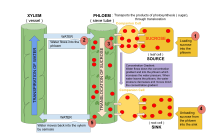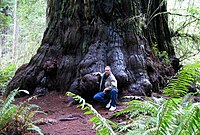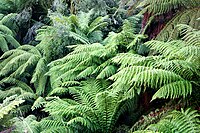Plant stem
This article needs additional citations for verification. (March 2022) |


A stem is on of two main structural axes of a vascular plant, the other being the root. It supports leaves, flowers and fruits, transports water and dissolved substances between the roots and the shoots in the xylem and phloem, photosynthesis takes place here, stores nutrients, and produces new living tissue.[1] The stem can also be called halm or haulm or culms.
The stem is normally divided into nodes and internodes:[2]
- The nodes are the points of attachment for leaves and can hold one or more leaves. There are sometimes axillary tendrilsfrom nodes.
- The internodes distance one node from another.[2]
The term "shoots" is often confused with "stems"; "shoots" generally refers to new fresh plant growth, including both stems and other structures like leaves or flowers.[2]
In most plants, stems are located above the soil surface, but some plants have underground stems.
Stems have several main functions:[3]
- Support for and the elevation of leaves, flowers, and fruits. The stems keep the leaves in the light and provide a place for the plant to keep its flowers and fruits.
- Transport of fluids between the roots and the shoots in the xylem and phloem.
- Storage of nutrients.
- Production of new living tissue. The normal lifespan of plant cells is one to three years. Stems have cells called meristems that annually generate new living tissue.
- Photosynthesis.
Stems have two pipe-like tissues called
Specialized terms
Stems are often specialized for storage, asexual reproduction, protection, or photosynthesis, including the following:

- Acaulescent: Used to describe stems in plants that appear to be stemless. Actually these stems are just extremely short, the leaves appearing to rise directly out of the ground, e.g. some Viola species.
- Arborescent: Tree with woody stems normally with a single trunk.
- Axillary bud: A bud which grows at the point of attachment of an older leaf with the stem. It potentially gives rise to a shoot.
- Branched: Aerial stems are described as being branched or unbranched.
- Bud: An embryonic shoot with immature stem tip.
- daffodil, and tulip. Bulbs often function in reproduction by splitting to form new bulbs or producing small new bulbs termed bulblets. Bulbs are a combination of stem and leaves so may better be considered as leaves because the leaves make up the greater part.
- Caespitose: When stems grow in a tangled mass or clump or in low growing mats.
- Cladode (including phylloclade): A flattened stem that appears leaf-like and is specialized for photosynthesis,[4] e.g. cactus pads.
- Climbing: Stems that cling or wrap around other plants or structures.
- Corm: A short enlarged underground storage stem, e.g. taro, crocus, gladiolus.

- Decumbent: A stem that lies flat on the ground and turns upwards at the ends.
- Fruticose: Stems that grow shrublike with woody like habit.
- Herbaceous: Non woody stems which die at the end of the growing season.
- Internode: An interval between two successive nodes. It possesses the ability to elongate, either from its base or from its extremity depending on the species.
- Node: A point of attachment of a leaf or a twig on the stem in seed plants. A node is a very small growth zone.
- infrutescence.
- Peduncle: A stem that supports an inflorescence or a solitary flower.
- Prickle: A sharpened extension of the stem's outer layers, e.g. roses.
- Pseudostem: A false stem made of the rolled bases of leaves, which may be 2 to 3 m (6 ft 7 in to 9 ft 10 in) tall, as in banana.
- Rhizome: A horizontal underground stem that functions mainly in reproduction but also in storage, e.g. most ferns, iris.
- garden strawberry, Chlorophytum comosum.
- .
- Stolon: A horizontal stem that produces rooted plantlets at its nodes and ends, forming near the surface of the ground.
- Thorn: A modified stemwith a sharpened point.
- Tuber: A swollen, underground storage stem adapted for storage and reproduction, e.g. potato.
- Woody: Hard textured stems with secondary xylem.
- Sapwood: A woody stem, the layer of secondary phloem that surrounds the heartwood; usually active in fluid transport
Stem structure

Stem usually consist of three tissues: dermal tissue, ground tissue, and vascular tissue.[5]
Dermal tissue covers the outer surface of the stem and usually functions to protect the stem tissue, and control gas exchange.[6] The predominant cells of dermal tissue are epidermal cells.[7] The dermal tissue of aquatic plants stems may lack the waterproofing found in aerial stems.
Ground tissue usually consists mainly of parenchyma cells and fills in around the vascular tissue. It sometimes functions in photosynthesis. Most or all ground tissue may be lost in woody stems.
Vascular tissue provides long distance transport and structural support. The arrangement of the vascular tissues varies widely among plant species.
Dicot stems
Woody dicots and many nonwoody dicots have
Secondary
Monocot stems

Vascular bundles are present throughout the
Gymnosperm stems
All gymnosperms are woody plants. Their stems are similar in structure to woody dicots except that most gymnosperms produce only tracheids in their xylem, not the vessels found in dicots. Gymnosperm wood also often contains resin ducts. Woody dicots are called hardwoods, e.g. oak, maple and walnut. In contrast, softwoods are gymnosperms, such as pine, spruce and fir.
-
The trunk of this redwood tree is its stem.
Fern stems
Most ferns have rhizomes with no vertical stem. The exception is tree ferns, which have vertical stems that can grow up to about 20 metres. The stem anatomy of ferns is more complicated than that of dicots because fern stems often have one or more leaf gaps in cross section. A leaf gap is where the vascular tissue branches off to a frond. In cross section, the vascular tissue does not form a complete cylinder where a leaf gap occurs. Fern stems may have solenosteles or dictyosteles or variations of them. Many fern stems have phloem tissue on both sides of the xylem in cross-section.
-
Tasmanian tree fern
Relation to xenobiotics
Foreign chemicals such as air pollutants,[8] herbicides and pesticides can damage stem structures.
Economic importance

There are thousands of species whose stems have economic uses. Stems provide a few major staple crops such as potato and
Medicines obtained from stems include quinine from the bark of cinchona trees, camphor distilled from wood of a tree in the same genus that provides cinnamon, and the muscle relaxant curare from the bark of tropical vines.
Wood is used in thousands of ways; it can be used to create
Some ornamental plants are grown mainly for their attractive stems, e.g.:
- White bark of paper birch
- Twisted branches of corkscrew willow and Harry Lauder's walking stick(Corylus avellana 'Contorta')
- Red, peeling bark of paperbark maple
See also
References
- ISBN 978-0-08-053908-9.
- ^ ISBN 9788171549719.
- ISBN 0-87901-132-7.
- ^ Goebel, K.E.v. (1969) [1905]. Organography of plants, especially of the Archegoniatae and Spermaphyta. New York: Hofner publishing company.
- ^ "Stem Anatomy". LibreTexts Biology. 11 May 2024. Retrieved 11 May 2024.
- ^ "Stems - Stem Anatomy". LibreTexts Biology. 11 June 2024. Retrieved 11 June 2024.
- ^ "Stems - Stem Anatomy". LibreTexts Biology. 11 June 2024. Retrieved 11 June 2024.
- ^ C. Michael Hogan. 2010. "Abiotic factor". Encyclopedia of Earth. Emily Monosson and C. Cleveland, eds. National Council for Science and the Environment Archived 2013-06-08 at the Wayback Machine. Washington, D.C.
Further reading
- Speck, T.; Burgert, I. (2011). "Plant Stems: Functional Design and Mechanics". .
External links
 Media related to Plant stems at Wikimedia Commons
Media related to Plant stems at Wikimedia Commons- Overview of stem anatomy


